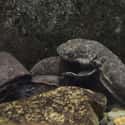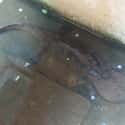-
(#1) The Largest Salamanders Can Be Nearly Six Feet Long
The Chinese giant salamander is the largest amphibian on Earth. While the average size for the species is around 3.5 feet, one salamander in the wild measured out to an astonishing 5.9 feet, which is a record for this species. These animals are barely over an inch long as tadpoles, making their monstrous size even more impressive. They grow slowly over the course of their lives, not reaching sexual maturity until they are about 5 years old. In captivity, Chinese giant salamanders have been documented to live for up to 60 years.
They’re also packing some serious meat on their bones. The average giant salamander weighs about 66 pounds, which is pretty remarkable for an amphibian.
-
(#2) Salamander Farms Sell These Animals As Gourmet Food
Unfortunately, the Chinese giant salamander is critically endangered in the wild and is facing extinction. These bizarre looking creatures are a delicacy in China, where salamander farming is a booming business. There are currently tens of millions of giant salamanders being raised for consumption in the country, most of which are either captured in the wild or bred from poached salamanders. Even though there is such a large captive population, it won’t be enough to save these animals in the long term.
Giant salamanders make their home in waters that are increasingly being polluted as a result of rapid industrialization. On top of that, they are often poached and sold for their meat. Their numbers have dropped 80% since the 1950s and less than 50,000 exist in the wild in the 21st century. The Chinese government tried to release a number of farm-raised salamanders into the wild to help balance the numbers, but ironically, the farm-raised carried infectious diseases into the waters, killing more of the wild population. It looks like the only hope for the species's continued survival is to raise awareness in China about their dire situation.
-
(#3) They Are Part Of A Lineage That Stretches Back To The Jurassic Period
Sluggish and primordial, giant salamanders could easily be mistaken for dinosaurs. They just look prehistoric, and that’s because they kind of are. The distant ancestors of these salamanders first split off into their own family tree 170 million years ago, during the height of the Jurassic period. Not much has changed since Cryptobranchidae, the family name of this branch of salamander, initially evolved. It’s likely that some of them were eaten by dinosaurs, as they would have certainly come into contact with each other.
-
(#4) They Are Adept Predators, But Are Increasingly Being Hunted Themselves
Not surprisingly, these lumbering giants are highly successful predators. They will consume all sorts of different prey, but they specialize in small arthropods like crustaceans and insects as well as other aquatic species. Fish and other amphibians are also important parts of the giant salamander's diet.
Giant salamanders have been increasingly hunted themselves, mostly by poachers looking to make a quick buck. As their population declines, poachers have stooped to using dynamite and poisonous chemicals to suss out the rare amphibians. These hunting strategies are not only killing the salamanders, but they could also be harming their sources of food.
-
(#5) They Are Sometimes Called 'Baby Fish' Because They Sound Like Crying Infants
There are a lot of creepy things about Chinese salamanders; they have slimy skin, beady eyes, and a mouth that looks big enough to swallow a cat whole. But all of these features are nowhere near as terrifying as the sound they make.
The Chinese will sometimes refer to the salamander as a “baby fish,” a nickname that is probably too cute for such an ugly creature. They call it that because, when in distress, giant salamanders emit a whining wail that sounds eerily similar to a crying human baby. So, if you’re ever exploring rural China and hear a ghostly cry coming from the water, don’t worry - you’re not dealing with an evil spirit. You likely freaked out a giant salamander.
-
(#6) False Reports Greatly Exaggerated Their Lifespan
There was a media frenzy after a four-foot salamander that weighed over 100 pounds was discovered by a fisherman in China. Based on information from local Chinese sources, news outlets quickly published unverified details that described the animal as being roughly 200 years old. Researchers at UC Berkley called the claim “a big stretch.” Scientists believe that the average lifespan of the salamander is less than a quarter of that number, with some of the oldest captive specimens only living to a maximum of 50 years.
-
(#7) The Ying And Yang Symbol May Have Originally Featured Giant Salamanders
According to the BBC, these salamanders might be responsible for one of the most iconic images on earth. The classic depiction of yin and yang is a symbol of great importance when it comes to the philosophy of Taoism, a Chinese religion and school of thought. It is possible that this beautiful symbol was originally shown as illustrations of two salamanders, which is a pretty breathtaking result coming from such an ugly animal.
-
(#8) Fathers Build Dens To Protect Their Eggs
While these massive simpletons might not seem like they would be very good parents, giant salamander fathers take good care of their unborn young. They construct elaborate breeding dens deep underwater, usually under a crevasse or a particularly big rock. Males invite females to mate in the den, and one male might watch over the broods of many females. Once the eggs are laid, the rest of the responsibility lands solely on the dad’s shoulders. Fathers must watch over the eggs until they hatch, which usually takes a little over a month. After the tadpoles emerge, the dad leaves the newborns to fend for themselves.
-
(#9) They Breathe Through Their Skin
In general, amphibians are pretty bizarre. They are cold blooded, extremely sensitive to environmental changes, and go through an extreme metamorphosis from tadpole to adult. They can also breath and absorb water through their skin, a trick that helps them survive both in the water and on land. But their unique skin also makes them very vulnerable. Amphibians can’t help but soak up any toxic chemicals they come into contact with, and they often are the first to die off due to the effects of pollution. The giant Chinese salamander is no exception to this rule and their numbers have been severely effected by increased levels of habitat contamination.
-
(#10) Terrible Eyesight Means They Rely On Other Senses
Despite having such big heads, giant salamanders have seriously tiny eyes and pretty horrendous eyesight. However, this doesn't pose too much of a problem for them. Giant salamanders have evolved over millions of years to rely on their other senses to find prey and navigate their territory. Their entire bodies are covered in sensory nodes that greatly amplify their sense of touch. They can detect even the slightest movements and vibrations in the water. They also have a keen sense of smell which helps them find food.
-
(#11) They Can Excrete A Deadly Toxin From Their Skin
Predators beware, the giant Chinese salamander has a handy trick to deal with potential enemies. When threatened, they can produce a toxic enzyme that is released through the skin. This enzyme can have seriously debilitating effects on mammals, including symptoms like edema and nociception. High concentrations of this enzyme have been observed to cause death in lab rats.
New Random Displays Display All By Ranking
About This Tool
Chinese giant salamander is an amphibian that lives in freshwater. This is a rare and unique wild animal in China. Although it lives in the water, it is not a fish, but the largest amphibian on earth. Their body length is generally about 1 meter, and the longest can reach 2 meters. Wild Chinese giant salamander generally active in clear, low-temperature streams or natural caves, inhabiting mud or dark rock crevices.
Chinese giant salamanders are extremely rare animals, and the rapid decline in habitat and pollution caused the number of Chinese giant salamanders to decrease sharply, which is also the main reason why this species is endangered. Here the random tool introduced 11 details about the largest amphibian.
Our data comes from Ranker, If you want to participate in the ranking of items displayed on this page, please click here.





















